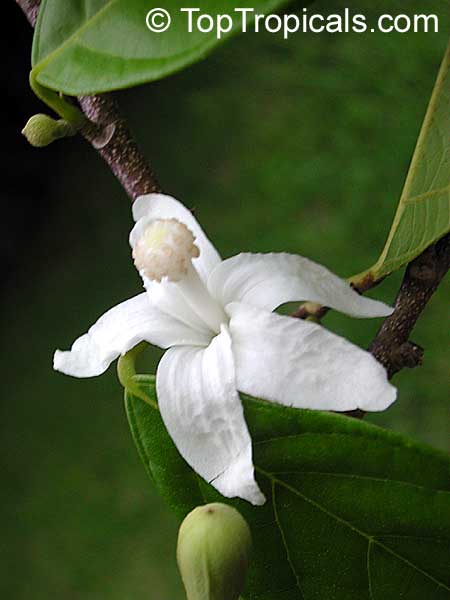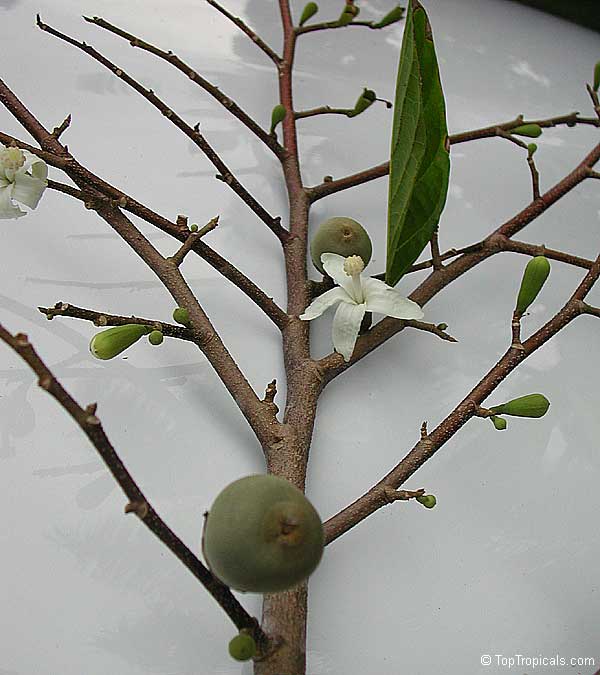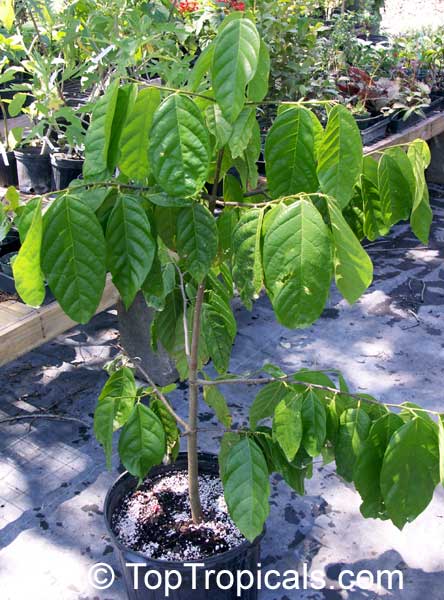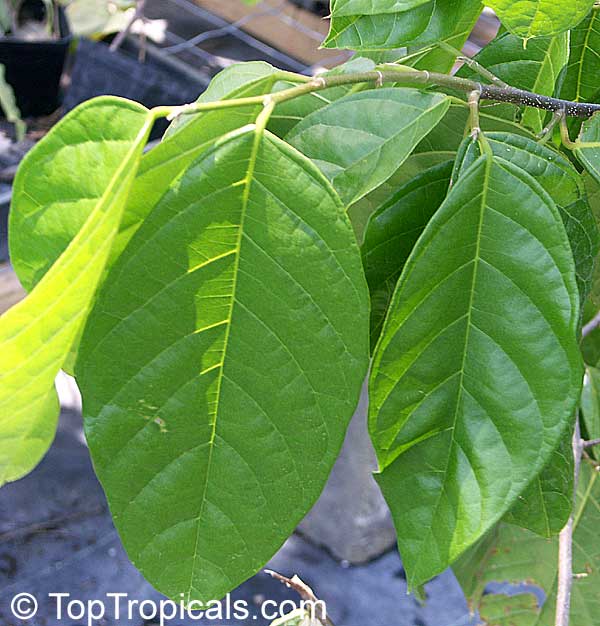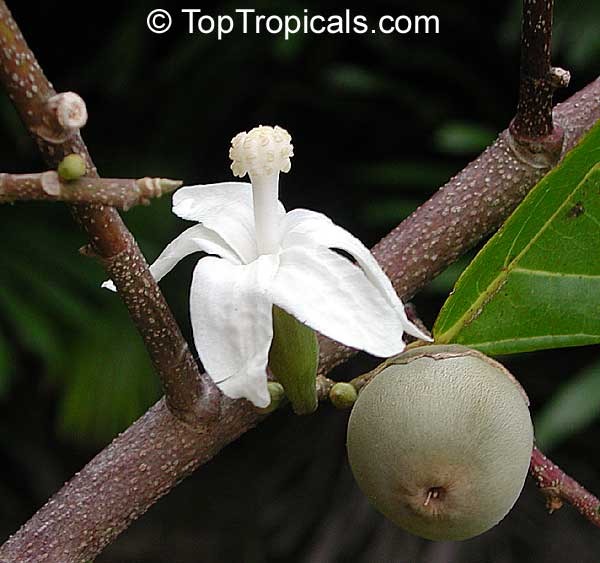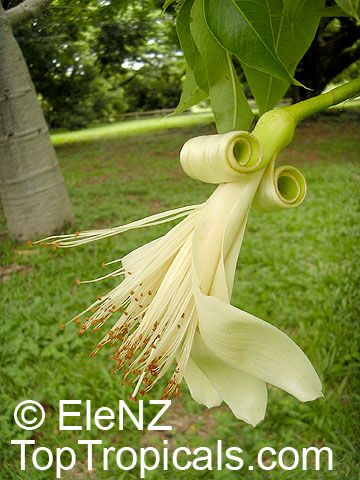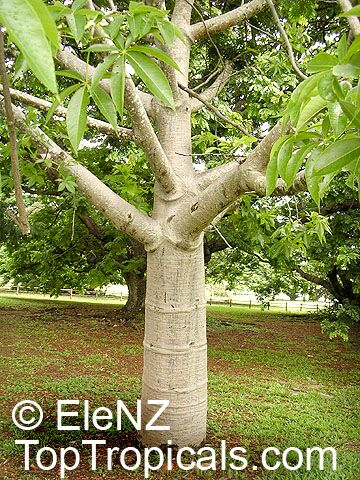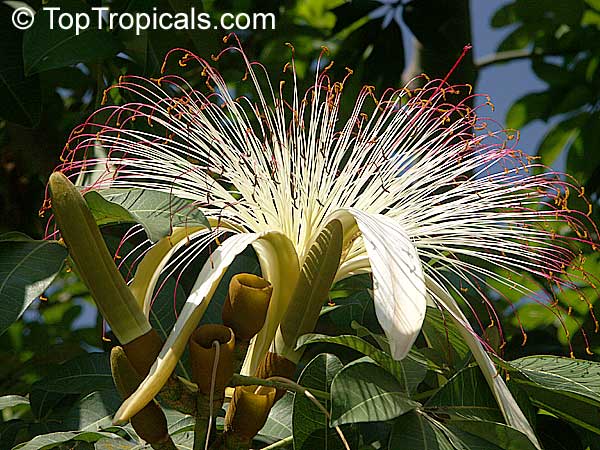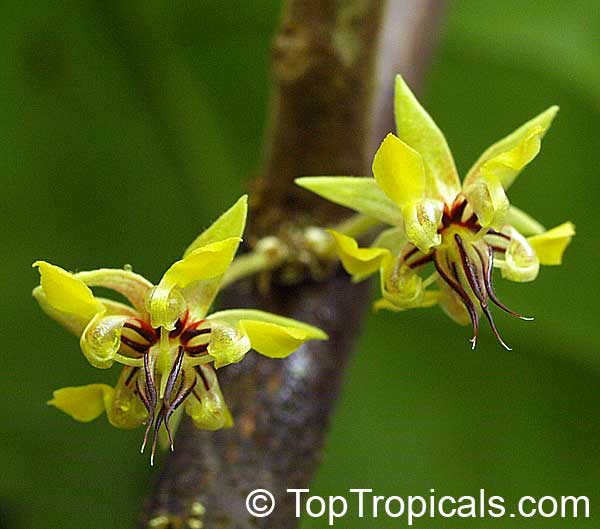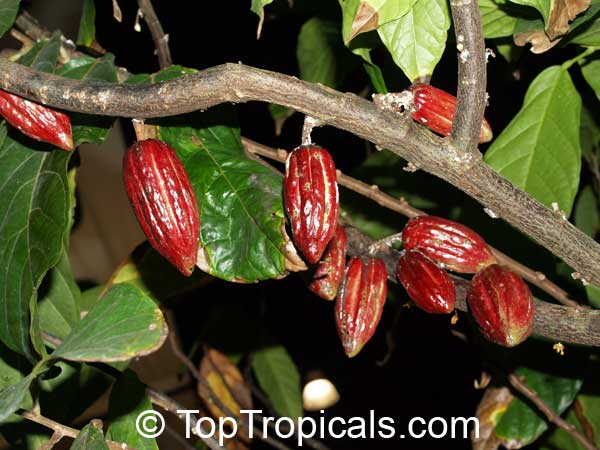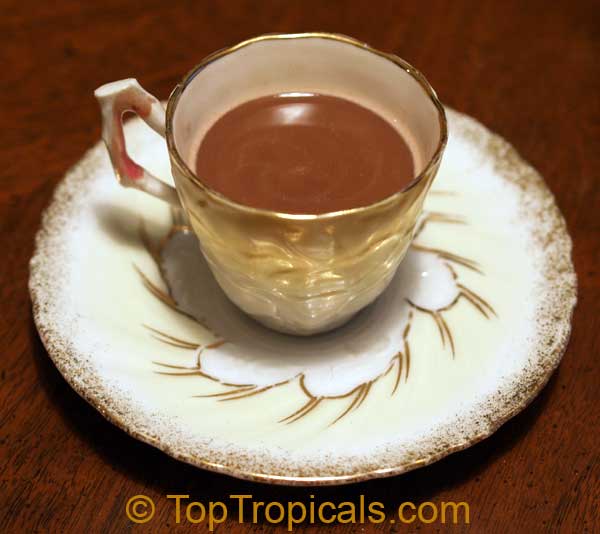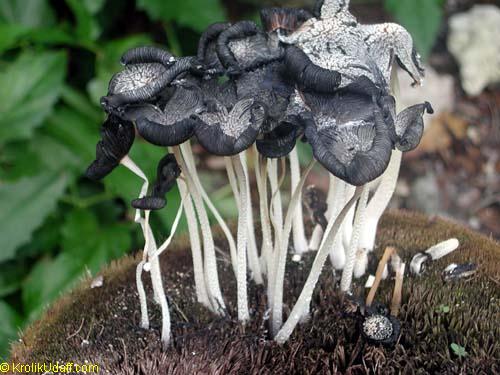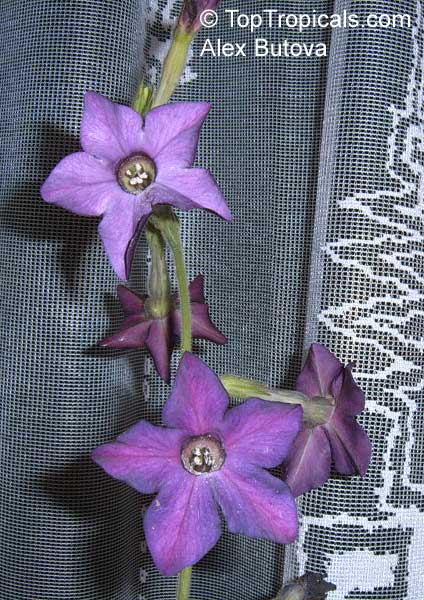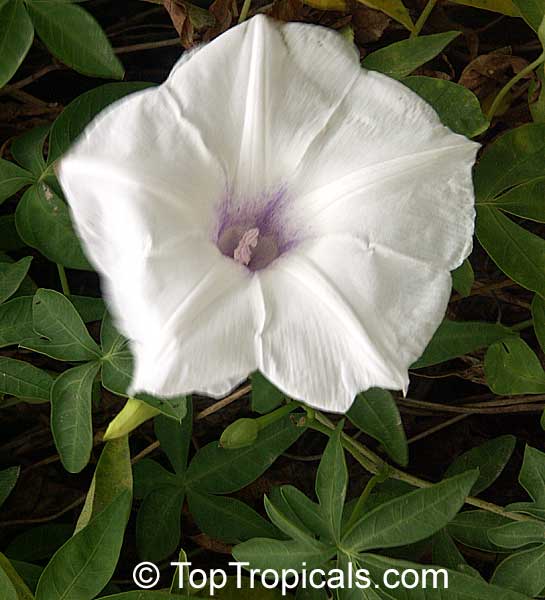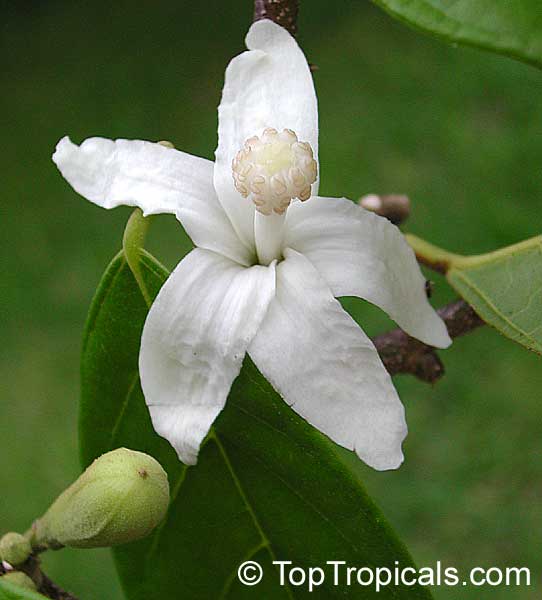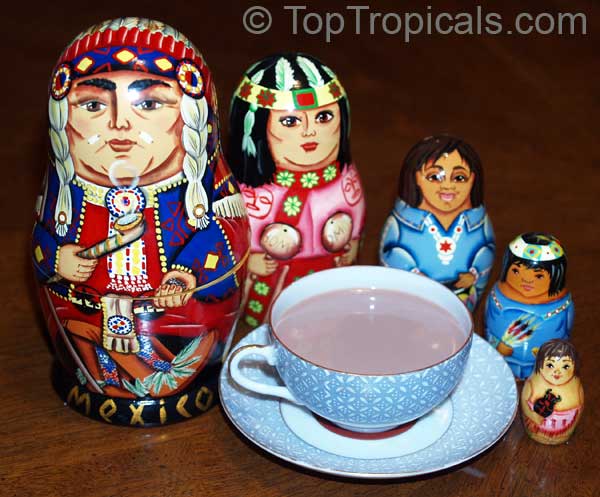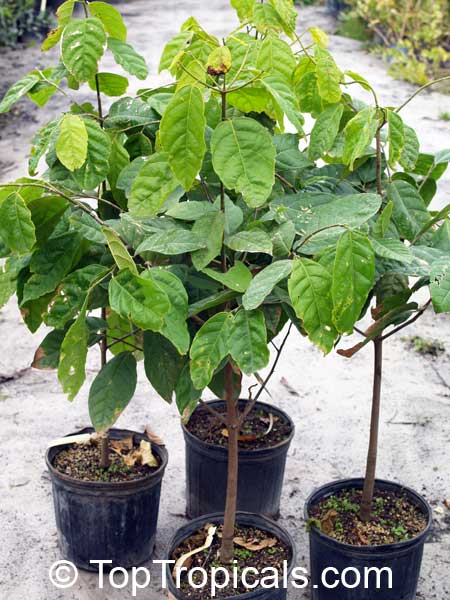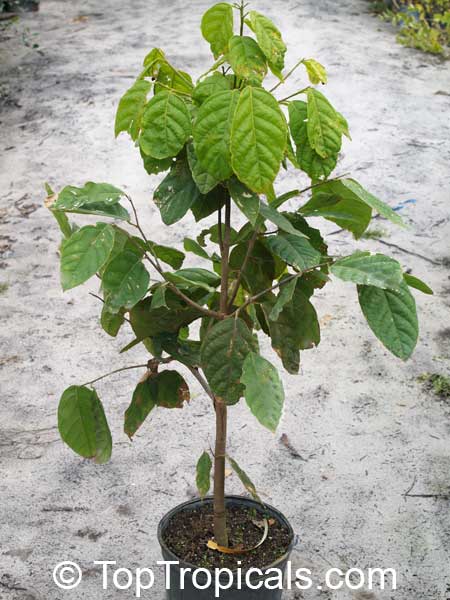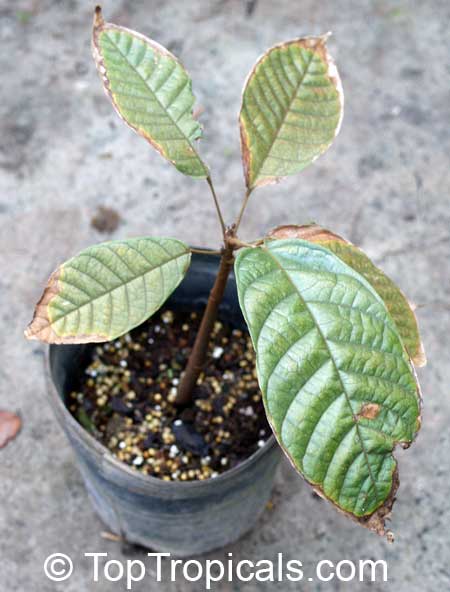Featured plant - a special for your collection
Quararibea funebris - Rosita de Cacao and Drink of the Gods
Scientific name: Quararibea funebris, Lexarza funebris
Common names: Rosita de Cacao, Cacao Flower, Flor de Cacao, Madre Cacao
Aztec names: Poyomatli, Xochicacaohuatl, Flor Cacahuaxochitl, Cacaoxochitl
Family: Bombacaceae
Origin: Southern Mexico, Guatemala
Potted specimen
Leaves
Quararibea funebris, or Rosita de Cacao, is a beautiful, rare exotic flowering tree of a medium to large size and is considered an obscure spice. It originates from Mexico and South America and is a close relative of Chupa-Chupa (Quararibea cordata) and is known for its fragrant white flowers (1-2" wide) which yield an aromatic spice; it is followed by a small aromatic fruit. This evergreen shade tree is very ornamental and has large leathery green leaves up to 15" long and symmetrical, speading crown. The species was at one time widespread and growing wild throughout the Oaxaca region of Mexico. Due to deforestation, it lost its once wide growth range. Oaxaca is also known for at least two plants which are native to this particular area of the world, both used in Shamanism: Psilocybe mushrooms and Salvia divinorum.
The tree is somewhat hardy and able to survive brief temperature drops to the 30s. It has a relatively slow growth rate, and a round shape of the crown, doesn't require much pruning and looks nice and neat as a landscape centerpiece or specimen plant. The plant can be easily grown in container, where it doesn't grow very tall.
It was known in the ancient times by names of Poyomatli, Xochicacaohuatl or Cacahuaxochitl. These words literally mean, "flower of cacao" even though the plant is not botanically related to cacao. The Aztecs used its highly pungent flowers, known as Cacaoxochitl, to flavor their chocolate drinks. In Mexico today these flowers are known in Spanish as "Flor de Cacao" or "Rosita de Cacao" or "Madre Cacao".
Related species: Adansonia digitata (Baobab), Bombax ceiba (Kapok Tree), Chorisia speciosa (Silk Floss Tree), Durio zibethinus (Durian), Pachira aquatica (Malabar Chestnut), Quararibea cordata (South American Sapote), and other species of Bombacaceae Family.
Bombax ceiba and Chorisia speciosa
Pachira aquatica and Quararibea cordata
A tasty snack and drink
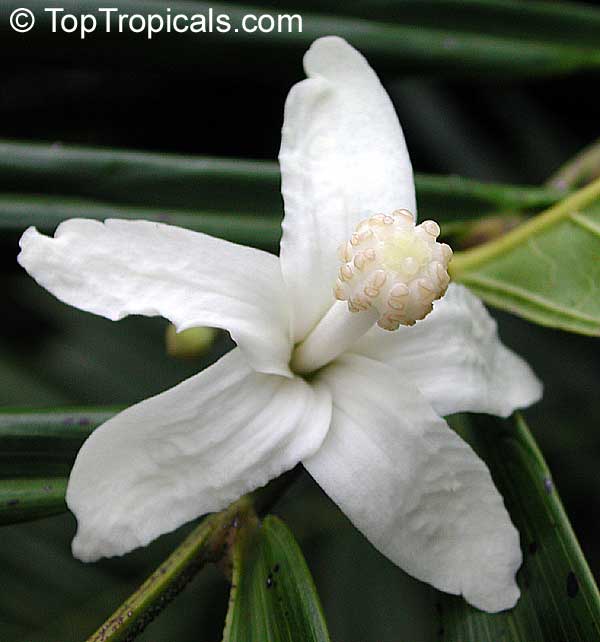
The entire flower of Quararibea funebris is edible. The stamen, pistil and petals may be easily pulled out of the sepal and eaten raw.
This flower was traditionally eaten by itself as a tasty popcorn-like snack or even smoked with tobacco. They can be grounded down or blended and added to home-made chocolate bars, cacao (chocolate) drinks, desserts, and even to guacamole.
Besides flavoring chocolate and making desserts, the native peoples used the plant for preserving food and bodies. The fragrance stays in dry flowers for decades, thus they were used for funeral ceremonies and were found in crypts still fragrant after many years. This feature of the flower gave another common name to the plant - Funeral Tree.
Flowers are also used to produce perfume. Dried flowers used at weddings and festivals by Indians.
The Aztecs used it for fishing: scented wood of this tree attracts fishes.
Chocolate and the Tejate - Drink of the Gods
Cacao beans
This aromatic tree produces flowers that are closely associated with traditional cacao use. Long before the arrival of the Spanish in Mexico, the Aztecs used these highly pungent flowers, known as Cacaoxochitl, to flavor their chocolate drinks. It was known in the ancient times by names of Poyomatli, Xochicacaohuatl or Cacahuaxochitl. These words literally mean, "flower of cacao" even though the plant is not botanically related to cacao. In Mexico today these flowers are known in Spanish as "flor de cacao" or "rosita de cacao" or "madre cacao".
The flowers are mixed with chocolate and other ingredients to concoct Oaxacan cacao drink tejate, a spicy beverage with medicinal and religious significance. This energy drink, "the drink of the gods" was originally served only to the ruling elite of Aztecs. They also used to drink cold chocolate mixed with corn and the Rosita de Cacao which they called Poyomatli.
The earliest known record of Rosita de Cacao was noted in 1582 in The General History of New Spain by Fray Bernardino de Sahagun where he affirmed that the name comes from Cacahuaxochitl and means "cacao flower" or Xochicacahuatl which means "precious flowers" and has fragrant and penetrating odor.
Cacao fruit
Flowers of
Theobroma cacao
Yellow Cacao
Red Cacao

Oaxacan hands

Nicuatole
Tejate is one of the most celebrated traditions in Mexican state of Oaxaca. Like most Mexcian delicacies, it is very complex in its composition. It is made from corn, roasted cacao beans, mamey seed and Rosita de Cacao flowers.
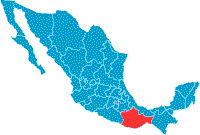 For tejate preparation the corn is boiled in water mixed with ashes, seed of Mamey (Pouteria sapota) and the Rosita de Cacao. The ingredients are hand-blended by famous tejateras (tejate makers) in a thick mass, which is gradually thinned with water. The drink is served in the traditional small hand-painted bowls called jicaras decorated by Oaxacan hands. Tejate has gained in popularity and has led to other products such as cookies, ice cream and a dessert known as Nicuatole, a Oaxacan-style corn pudding.
For tejate preparation the corn is boiled in water mixed with ashes, seed of Mamey (Pouteria sapota) and the Rosita de Cacao. The ingredients are hand-blended by famous tejateras (tejate makers) in a thick mass, which is gradually thinned with water. The drink is served in the traditional small hand-painted bowls called jicaras decorated by Oaxacan hands. Tejate has gained in popularity and has led to other products such as cookies, ice cream and a dessert known as Nicuatole, a Oaxacan-style corn pudding.
The Feria del Tejate (Tejate Fair) in Oaxaca is held the February when over 15,000 visitors show up to sample the delicious drink. For this occasion, 120 tejateras participate using an average of 1000 lbs of cacao, 36,000 mamey fruits, 250 lbs of the Rosita de Cacao, and 5000 lbs of corn in order to prepare more than 3000 gallons of this drink.
Mamey fruit
Montezuma's Secret Exotic Aphrodisiac Beverage
Legend tells that the Aztec Emperor Montezuma drank 50 cups of a cold chocolate drink (xocolatl) per day, making him perhaps the greatest chocoholic of all time. He took no other beverage than the xocolatl, flavored with Vanilla, Rosita de Cacao, and other spices. It had consistency of honey and slowly dissolved in the mouth. Montezuma consumed his xocolatl in goblets before entering his harem and this led to the belief xocolatl was an aphrodisiac.
When Cortez burst into the 1520's Aztec court, he discovered the aged Montezuma reveling in the pastime of a royal harem. Upon learning that the basis for this royal pleasuring was an aphrodisiac brew forbidden to all but the court,
Besides cacao the drink contained Chilies, Vanilla beans and Cacahuaxochitl (Rosita de Cacao) and other herb indigrients.
Prince of Flowers
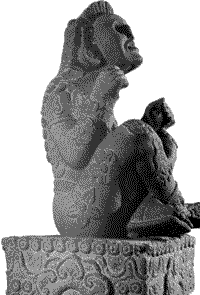
In the mid-1800's, a 16th century Aztec statue of Xochipilli was unearthed on the side of the volcano Popocatapetl. Xochipilli, The Prince of Flowers, is the Aztec god of flowers, maize, love, games, beauty, song and dance (Xochitl = flower, pilli = Prince). He is also referred to as Macuilxochitl, which means "five flowers".
The figure is seated upon a temple-like base, and both the statue and the base are covered in carvings of sacred and psychoactive plants including Mushroom (Psilocybe aztecorum), flower of Tobacco (Nicotiana tabacum), flower of Morning Glory (Turbina corymbosa), an unopened flower of Sinicuichi (Heimia salicifolia), an unopened flower of Cacahuaxochitl (Quararibea funebris), and one unidentified flower that is believed to be a stylized cap of Psylocybe aztecorum Mushroom. The statue is now displayed in the Mexican Anthropological Museum.
It is believed that Xochipilli is presented in a pose of an ecstasy. The position and expression of the body, in combination with the very clear representations of hallucinogenic plants which are known to have been used in sacred contexts by the Aztec support this interpretation.





stylized caps of
Psylocybe aztecorum
Mushroom
Cacahuaxochitl
(Rosita de Cacao)

Heimia salicifolia
Medicinal properties
Rosita de Cacao has been used as a medicinal plant. For possibly thousands of years, the natives of the Oaxaca region of Mexico used Rosita de cacao and tejate in the treatment of anxiety, fever and coughs.
Flowers yield a newly discovered lactone alkaloid, named funebradiol, and contain other lactone alkaloids: funebral and funebrine. These compounds possess subtle relaxing properties that are activated when added to cacao and tejate. Lactones gained the attention as the active ingredient in the Polynesian root Kava Kava with its calming effect. The chemicals responsible for the spicy odor are now under investigation as antitumor agents.
Chocolate drink recipes
Ingredients:
- 1 ounce unsweetened baking chocolate
- 1 teaspoon of vanilla
- 2/3 cups boiling water
- ground pepper of chilies to taste
- 1 teaspoon of dried flowers of Rosita de Cacao
Grate the unsweetened chocolate into a bowl and cover it with a little of the boiling water. Mash the mixture into a paste. Add the rest of the water, grounded flowers and vanilla and beat with an electric mixer until frothy. Add the pepper and chilies to spice up the drink. The chocolate will not totally dissolve and will have a grittiness to it. For a more authentic drink let the mixture cool and then beat again until frothy and drink. You may add 3 teaspoons of sugar, plus a dash of Cinnamon or Allspice.
Mexican Style Hot Chocolate
Ingredients:
- 3 oz of Mexican Sweet Chocolate (found in the Mexican Food Markets. This chocolate is high in sugar and flavored with cinnamon and sometimes almonds. Ibarra and Abuelita are two popular brands)
- 1/2 gallon milk
- 1 Vanilla bean or a few frops of vanilla extract
- 1/8 teaspoon ground nutmeg
- 3 teaspoons of dried flowers of Rosita de Cacao
- 8 oz. Kahlua or other coffee liquer (optional)
- Whipped cream for garnish
Heat milk and chocolate stirring frequently to mix chocolate as it melts. If you're using the vanilla bean, split it open and scrape seeds into milk, add pod and proceed with heating milk and chocolate (remove bean pod before blending and serving). When milk is very hot and all chocolate is melted, add liquer if desired, dried flowers powder and nutmeg and put mixture in a blender and puree, or whisk by hand to mix well. Serve with whipped cream.
Order the plants:
 Qararibea funebris (Rosita de Cacao) - large bushy trees in 3 gal pots (see photo below)
Qararibea funebris (Rosita de Cacao) - large bushy trees in 3 gal pots (see photo below)
 Cacao Bean and Rosita de Cacao - save $20.00!
Cacao Bean and Rosita de Cacao - save $20.00!
Quararibea funebris -
Rosita de Cacao
(3 gal pot)
Quararibea funebris -
Rosita de Cacao
(3 gal pot)
Theobroma cacao -
Cacao Bean
(1 gal pot)
